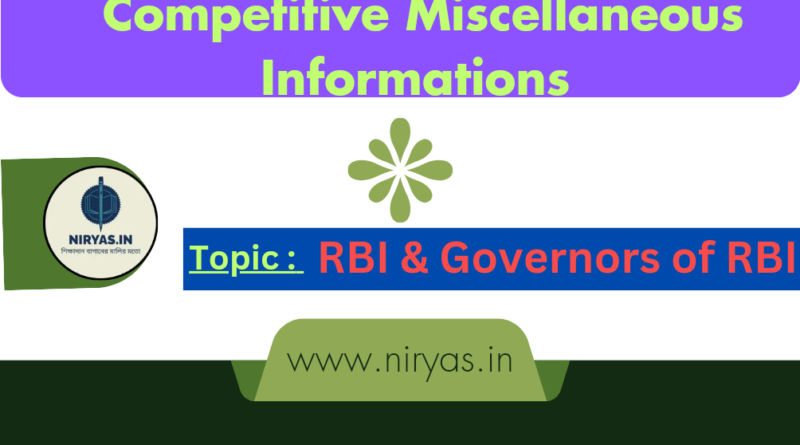RBI & Governors of RBI
RBI & Governors of RBI
Welcome to www.niryas.in. In the field of competitive exams, brief information on various subjects helps the competing students. Although there are numerous contents in this case, a proper idea about to-the-point information on several subjects keeps the competing students ahead. Based on some such contents, we have presented the Competitive Information Niryas sub-section of the Competitive Exam Preparation section. In this sub-section, in the post called RBI & Governors of RBI, we will now discuss some brief information related to RBI & 25 Governors of RBI. So let’s take a look at the information.
🔘 Reserve Bank of India (RBI)
➲ History : The RBI has a rich history, dating back to 1935. The Reserve Bank of India (RBI) was established on April 1, 1935, under the Reserve Bank of India Act, 1934 in Calcutta (Now Kolkata). Over the years, the RBI has played a crucial role in shaping the Indian economy and financial system. Some of the key milestones in the history of the RBI include:
i. Establishment : The RBI was established on April 1, 1935.
ii. Nationalization : The RBI was nationalized in 1949.
iii. Banking Regulation : The RBI was given the power to regulate the banking system in India in 1949.
iv. Monetary Policy : The RBI started formulating and implementing monetary policy in the 1950s.
iv. Financial Sector Reforms : The RBI played a key role in implementing financial sector reforms in India in the 1990s.
➲ Headquarters : The RBI is headquartered in Mumbai, Maharashtra, India. The Reserve Bank of India (RBI) was initially established in Kolkata (then known as Calcutta) in 1935, but its headquarters was later shifted to Mumbai in 1937.
➲ Objectives : The primary objectives of the RBI are:
i. To regulate the issue of banknotes and to maintain the currency and credit system of the country.
ii. To manage the foreign exchange of the country and to maintain the stability of the exchange rate.
iii. To act as a banker to the Government of India and to provide banking services to the government.
iv. To supervise and regulate the banking system in India.
➲ Functions : The RBI performs the following functions:
i. Monetary Policy : The RBI formulates and implements monetary policy to maintain price stability and promote economic growth.
ii. Banking Regulation : The RBI regulates and supervises the banking system in India to ensure the stability of the financial system.
iii. Currency Management : The RBI manages the currency and coinage system of the country.
iv. Foreign Exchange Management : The RBI manages the foreign exchange of the country and regulates the foreign exchange market.
v. Financial Stability : The RBI works to maintain financial stability and prevent financial crises.
RBI & Governors of RBI
➲ Organizational Structure : The RBI has a hierarchical organizational structure, with the following key positions:
i. Governor : The Governor is the chief executive officer of the RBI and is responsible for implementing the monetary policy and regulating the banking system.
ii. Deputy Governors : The Deputy Governors assist the Governor in implementing the monetary policy and regulating the banking system.
iii. Executive Directors : The Executive Directors are responsible for implementing the policies and decisions of the RBI.
➲ Regional Offices : The RBI has four regional offices, located in Mumbai, Delhi, Kolkata, and Chennai. These offices are responsible for implementing the policies and decisions of the RBI in their respective regions.
Here are the details about the Regional Offices of the Reserve Bank of India (RBI), including the established date and main functions:
➣ Mumbai Regional Office :
❖ Established Date: 1937 (as the Central Office of the RBI)
❖ Main Functions:
◈ Supervising and regulating banks and other financial institutions in the Western Region.
◈ Implementing monetary policy decisions.
◈ Managing currency and coin distribution.
◈ Providing banking services to the government and other customers.
➣ Delhi Regional Office :
❖ Established Date: 1949
❖ Main Functions:
◈ Supervising and regulating banks and other financial institutions in the Northern Region.
◈ Implementing monetary policy decisions.
◈ Managing currency and coin distribution. RBI & Governors of RBI
◈ Providing banking services to the government and other customers.
➣ Kolkata Regional Office :
❖ Established Date: 1949
❖ Main Functions:
◈ Supervising and regulating banks and other financial institutions in the Eastern Region.
◈ Implementing monetary policy decisions.
◈ Managing currency and coin distribution.
◈ Providing banking services to the government and other customers.
➣ Chennai Regional Office :
❖ Established Date: 1951
❖ Main Functions:
◈ Supervising and regulating banks and other financial institutions in the Southern Region.
◈ Implementing monetary policy decisions.
◈ Managing currency and coin distribution.
◈ Providing banking services to the government and other customers.
RBI & Governors of RBI
➲ Subsidiaries : The RBI has several subsidiaries, including:
i. Reserve Bank of India Staff College : The RBI Staff College provides training to the employees of the RBI.
ii. College of Agricultural Banking : The College of Agricultural Banking provides training to the employees of the RBI and other banks on agricultural banking.
iii. National Bank for Agriculture and Rural Development (NABARD) : NABARD is a subsidiary of the RBI and is responsible for providing credit to the agricultural sector.
Overall, the RBI plays a crucial role in maintaining the stability of the Indian economy and financial system, and has a rich history of serving the country.
➲ RBI Governors : The Reserve Bank of India (RBI) is the central banking institution of India, responsible for regulating the country’s monetary policy. The Governor of the RBI is the chief executive officer of the bank and plays a crucial role in shaping the country’s economic policies. In this essay, we will analyze the statistical trends and patterns in the tenure of the Governors of the RBI. RBI & Governors of RBI
➲ Tenure of Governors : The RBI has had 25 Governors since its inception in 1935. The average tenure of a Governor is approximately 5.5 years. However, there have been significant variations in the tenure of Governors over the years.
The longest-serving Governor was Sir Benegal Rama Rau, who served for 8 years from 1949 to 1957. On the other hand, the shortest-serving Governor was A Ghosh, who served for just 20 days in 1985.
➲ Distribution of Tenure : The distribution of tenure of Governors is skewed, with a majority of Governors serving for less than 5 years. Only 6 Governors have served for more than 7 years.
➲ Education and Background : The Governors of the RBI have come from diverse educational backgrounds. The majority of Governors have been economists, followed by bankers and administrators. The educational background of the Governors of the Reserve Bank of India is as follows:
Economics: 12 Governors
Banking: 6 Governors
Administration: 4 Governors
Law: 2 Governors
Other: 1 Governor RBI & Governors of RBI
RBI & Governors of RBI
➲ List of Governors of RBI (Reserve Bank of India) :
1. Sir Osborne Smith : (01-04-1935 to 30-06-1937)
✧ First Governor of the Reserve Bank
✧ Notable work: Professional banker with experience in Bank of New South Wales and Commonwealth Bank of Australia
✧ PM: None (pre-Independence India)
2. Sir James Taylor : (01-07-1937 to 17-02-1943)
✧ Member of the Indian Civil Service
✧ Notable work: Served in the Currency Department of the Government of India
✧ PM: None (pre-Independence India)
3. Sir C D Deshmukh : (11-08-1943 to 30-06-1949)
✧ First Indian Governor of the Reserve Bank
✧ Notable work: Represented India at the Bretton Woods negotiations in 1944
✧ PM: Jawaharlal Nehru
4. Sir Benegal Rama Rau : (01-07-1949 to 14-01-1957)
✧ Longest-serving Governor of the Reserve Bank
✧ Notable work: Introduced innovative initiatives in co-operative credit and industrial finance
✧ PM: Jawaharlal Nehru
5. K G Ambegaonkar : (14-01-1957 to 28-02-1957)
✧ Interim Governor
✧ Notable work: Forged closer connections between agricultural enterprise and the Reserve Bank’s operations
✧ PM: Jawaharlal Nehru
6. H V R Iengar : (01-03-1957 to 28-02-1962)
✧ Notable work: Introduced decimal coinage in India; Consolidated the banking industry
✧ PM: Jawaharlal Nehru
7. P C Bhattacharya : (01-03-1962 to 30-06-1967)
✧ Notable work: Established the Industrial Development Bank of India; Introduced the Credit Authorisation Scheme
✧ PM: Jawaharlal Nehru, Lal Bahadur Shastri, and Indira Gandhi
8. L K Jha : (01-07-1967 to 03-05-1970)
✧ Notable work: Introduced social controls over commercial banks; Nationalized 14 major commercial banks
✧ PM: Indira Gandhi
9. B N Adarkar : (04-05-1970 to 15-06-1970)
✧ Interim Governor
✧ Professional economist
✧ PM: Indira Gandhi
10. S Jagannathan : (16-06-1970 to 19-05-1975)
✧ Notable work: Active monetary policy to control inflation; Expanded banking offices in rural areas
✧ PM: Indira Gandhi
11. N C Sen Gupta : (19-05-1975 to 19-08-1975)
✧ Interim Governor
✧ Served as Secretary to the Department of Banking
✧ PM: Indira Gandhi
12. K R Puri : (20-08-1975 to 02-05-1977)
✧ Notable work: Set up Regional Rural Banks; Introduced the twenty-point economic programme
✧ PM: Indira Gandhi
RBI & Governors of RBI
13. M Narasimham : (02-05-1977 to 30-11-1977)
✧ Notable work: First Governor appointed from the Reserve Bank cadre
✧ PM: Morarji Desai
14. Dr. I G Patel : (01-12-1977 to 15-09-1982)
✧ Notable work: Demonetisation of high denomination notes, introduction of gold auctions
✧ PM: Morarji Desai, Charan Singh, and Indira Gandhi
15. Dr. Manmohan Singh : (16-09-1982 to 14-01-1985)
✧ Notable work: Comprehensive legal reforms in the banking sector
✧ PM: Indira Gandhi
16. A Ghosh : (15-01-1985 to 04-02-1985)
✧ Notable work: Brief tenure as Governor
✧ PM: Rajiv Gandhi
17. R N Malhotra : (04-02-1985 to 22-12-1990)
✧ Notable work: Development of money markets, introduction of new instruments
✧ PM: Rajiv Gandhi
18. S Venkitaramanan : (22-12-1990 to 21-12-1992)
✧ Notable work: Management of the balance of payments crisis
✧ PM: Chandra Shekhar and P. V. Narasimha Rao
19. Dr. C Rangarajan : (22-12-1992 to 21-11-1997)
✧ Notable work: Comprehensive reforms in the financial sector
✧ PM: P. V. Narasimha Rao and Atal Bihari Vajpayee
20. Dr. Bimal Jalan : (22-11-1997 to 06-09-2003)
✧ Notable work: Strengthening of the financial sector, introduction of new instruments
✧ PM: Atal Bihari Vajpayee
21. Dr. Y V Reddy : (06-09-2003 to 05-09-2008)
✧ Notable work: Management of the economy during the global financial crisis
✧ PM: Atal Bihari Vajpayee and Manmohan Singh
22. Dr. D. Subbarao : (05-09-2008 to 04-09-2013)
✧ Notable work: Management of the economy during the global financial crisis
✧ PM: Manmohan Singh
23. Dr. Raghuram Rajan : (04-09-2013 to 04-09-2016)
✧ Notable work: Implementation of inflation targeting, cleaning up of bank balance sheets
✧ PM: Manmohan Singh and Narendra Modi
24. Dr. Urjit R. Patel : (04-09-2016 to 10-12-2018)
✧ Notable work: Implementation of the Insolvency and Bankruptcy Code
✧ PM: Narendra Modi
25. Shri Shaktikanta Das : (12-12-2018 to present)
✧ Notable work: Management of the economy during the COVID-19 pandemic
✧ PM: Narendra Modi
Conclusion : The Governors of the RBI have played a crucial role in shaping the country’s economic policies. The statistical analysis of their tenure and background reveals interesting trends and patterns. While the average tenure of a Governor is approximately 5.5 years, there have been significant variations in the tenure of Governors over the years. The Governors have come from diverse educational backgrounds, with economists dominating the list.




